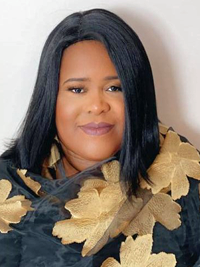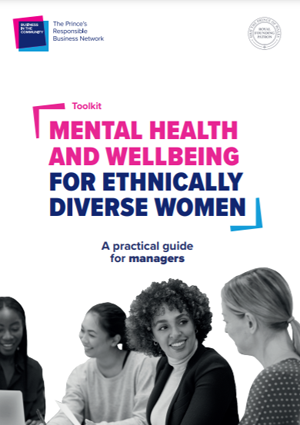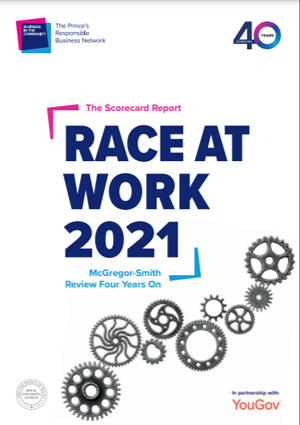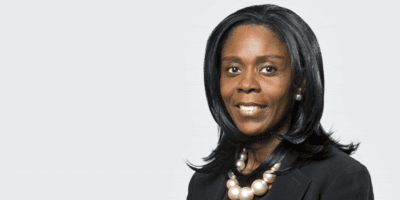Sandra Kerr CBE is Race Equality Director at Business in the Community. She works together with the Business in the Community Race Equality board to set the agenda for race diversity in the UK as a business imperative. Sandra strongly believes there is a need for wider business engagement to promote best practice for recruiting and developing ethnic minority individuals, marketing to ethnic minority people as profitable consumers, as well as including ethnic minority businesses and entrepreneurs in supply chains and networks.

“Through our campaigning work we know that Black and Asian people are more likely to be at lower levels in the workplace, and then if we look at women as part of that, they will be impacted even more, which needs to be flagged.”
Educational background and career to date
My educational background is that I went to college and did some higher education diplomas, but what I’ve been focusing on over the last 20 years is race equality, as well as diversity and inclusion more generally. Here at Business in the Community (BITC) I have been particularly focused on race equality. When we last spoke in 2017, I had an OBE but since the last interview, I was awarded a CBE for services to diversity and inclusion.
Role at BITC
The big area that I’ve been working on since we last spoke is the Race at Work Charter, which was established in 2018 85 employers, whereas now we have over 800. So that’s what we’re using to drive race equality in the UK.
In my key role at BITC, I work with business leaders across the UK landscape, as well as policymakers to look at how do we change the landscape and improve race equality in the workplace. And also, within the BITC, I provide a bit of internal support to help the organisation to think its own ethnicity pay gap, which we publish. (You can read about our figures on page 46 of our Annual Report.) We now have targets to improve the representation of ethnically diverse people across the organisation.
The main focus of my role though is external with employers and policymakers across the UK. There is a leadership team that works with me. We are meeting business leaders next week and help to shape our thinking and to listen to what they have to say to test that we are on point with the challenges that they face.
Impact of COVID
When considering the impact of COVID-19, the first thing we recognised when the extent of the pandemic became apparent was the potential economic impact. I knew from the 2008 crash that there was a more marked impact on Black, Asian and ethnically diverse people, so I knew that COVID would hit them harder too — they’re more likely to lose their jobs if an organisation downsizes, they’re the first to be released. They are also more likely to live in multi-generational households or to face higher housing costs, so I knew that there would be a challenge there.
I published a factsheet in May 2020 for employers and policy makers to say that they needed to think about the mental health of ethnically diverse women specifically because there is a disproportionate impact.
They are predominantly represented in frontline services, caring, the NHS, retail, or they may have a partner who is working in those services. Plus we know they are more likely to be in unstable zero-hour contract work. And as I say living within a multi-generational household. But not only that, we know that following the 2008 crash, 60% of ethnic minority people in the UK had no savings at all in 2010, so no financial cushion.
Through our campaigning work, we know that Black and Asian people are more likely to be at lower levels in the workplace, and then if we look at women as part of that, they will be impacted even more, which needs to be flagged. For this reason, I asked the ONS (Office for National Statistics) to make sure that they publish data by ethnicity group because if you remember in early 2020 when we first locked down we could see that the majority of nurses doctors and nurses that were dying were Black or Asian.
It’s only when they started to look at the data by different groups, they saw that there was a disproportionate impact of contagion and death, so the advice to employers was to be aware of that. There was a really important stat that I found through the 10 Downing Street Race Disparity Unit: In 2014 29% of black women reported a common mental health disorder, and it was 28.7%, for women from mixed ethnic backgrounds.

We put that together with funding from the Prince of Wales Foundation, because our campaign had been established for 25 years in 2020, so that funding was given to us to look at mental health and what we can do to support women.
That work came into sharper focus with the pandemic, the need to look at what was happening to those who identified as being Black and Mixed Race in the workplace because the mental health incidents were so high before the pandemic. When you then consider everything in the media, such as disproportionate incidents of stop and search, you realise that all of those people who are stopped, have mothers or sisters or aunts, there is a knock-on effect for women on the racial disparities that affect men as well.
The government convened a number of groups to try and figure out how can they reach people such as small business owners who, for multiple reasons, didn’t want some of the support, like government-backed loans because of the fear of debt. They already have challenges trying to get access to finance, so those same people who need the support the most would struggle to get access to it.
One of the things I felt was that the guidance needed to be in plain English and easy to understand. I was asking employers to double-check that their employees understood and that they had the confidence to apply for the support. That came into very sharp focus when we heard some of the challenges, particularly those working in the NHS not believing they could get the support that they needed, including timely access to PPE.
Against the backdrop of all this we had the death of George Floyd. When he died was when things really exploded with employers, employees, allies, Black and White people outside on the street saying: “We’ve had enough, we need change.” That really helped us shape what we were talking to employers about, and that was bringing in the white allies in the workplace, who really wanted to help support. We were able to say: “Let’s get their voices heard and get them supporting so that they can really help.”
The importance of allyship

I’ve included allyship as part of the Race at Work Charter. It had five commitments, which were:
- Leadership;
- Data;
- Zero tolerance to bullying harassment;
- Management engaging
It now has ‘Supporting allies in the workplace’, and also ‘Supply chain’.
Let’s support and encourage. I know some people think it’s virtue signalling, but it’s not. I want everybody who wants to see change empowered to make it happen.
Ethnicity pay gap reporting
The McGregor Smith Review into Ethnicity in the Workplace was commissioned by the government. Ruby McGregor Smith led this.
Three of the recommendations were about measurement and data. (One was about publishing the breakdown of your workforce, the second was about setting targets for recruitment and progression, and the third one was about ethnicity pay gap reporting.)
The government said at the time they stood by ready to act if employers didn’t voluntarily publish their pay gaps within the next 12 months. We did the review with them in 2018 and they asked me to put in the question about ethnicity pay gap reporting so that they could start the consultation.
That research came out and it said that only 11% of employers were capturing ethnicity pay gap data and publishing their ethnicity pay gaps. (Remember, at this point, gender pay gap reporting had been introduced but it didn’t naturally morph into the ethnicity pay gap reporting.) So, the consultation was started in October 2018, and it closed in January 2019.
Throughout 2019 I had regular meetings with the then business minister, Kelly Tollhurst MP and other stakeholders in BEIS (the Department for Business, Energy and Industrial Strategy – the lead policymakers responsible for the review), about how we were going to implement this phase, but then we had a change of Prime Minister and BEIS Minister and the push to get Brexit done, and then the pandemic, so things have just stalled.
In our Race at Work 2018 Survey, it had been 11% of employers publishing ethnicity pay gaps but it’s now risen to 19% in 2021. So, even with the government not taking any action at all, voluntary action has shifted from 11% to 19%.
I also asked our team at the BITC to check through every Race at Work Charter signatory to see who’s published their ethnicity pay gaps, and 20% of them have published this, so a strong correlation to the 19% that YouGov found. There’s also been an open letter to the Prime Minister from 30 business leaders, as well as a number of employer webinars, and a report. But with government, it’s stalled and I truly don’t know why. I’m still trying to find out.
Impact of suspension of enforcement of gender pay gap reporting at the start of the pandemic in 2020
At the start of the pandemic in 2020, the enforcement of Gender Pay Gap Reporting was paused, even though people had numbers ready to go for their 2019 reports (as most of the work had already been done), 50% of employers didn’t go ahead and report when allowed not to. That is another reason we need mandatory reporting.
What Womanthology readers do can to support BITC’s work
Going forward, the Race at Work Charter has seven commitments, as I mentioned earlier. We are working with the University of Birmingham to look at all the free-text comments we have received from the Race at Work Survey questions. I talked earlier about the issue of allyship There were almost 10,000 comments on that issue alone.
The university will be examining comments on allyship, on being overlooked for promotion, as well as helping bullying, harassment and leadership. They’ll be able to do longitudinal studies because we’ve captured this data and insight in the free text comments from employees from 2015, 2018 and 2021, so they’ll really be able to examine trends.
We will be looking at using that insight to better inform employers and policymakers around the lived experience of individuals in the workplace from the different demographic groups and profiles, so we will be able to look at what a Black woman from the Caribbean background or an Asian woman from a Pakistani or Bangladeshi background is saying on some of these issues. We anticipate the April 2022 census data will give us the current picture of how the UK landscape looks.
If we were asking readers what they can do to help, I’d say to have a look at our materials that we produce for women, on their mental health and wellbeing, and guidance for managers t. We’d welcome any kind of comments and suggestions of other things we should be looking at.
We are a listening organisation, so we want to hear voices from people and employers who feel we should look at particular issues they are facing. We will be focused on how we can provide more insight, more support, more factsheets, more advice to help employers drive forward on the seven commitments of the Race at Work Charter.
We believe that leadership needs to engage, and employers need to use data as evidence to make decisions. They need to make sure the culture is right so that people feel included and there’s no bullying and harassment allowed, and managers really engage and support their workforce. There needs to be a focus on progression. Allies need to be supported and empowered to feel safe so that if they speak up, nobody is going to come and tell them off afterward.
The more people that are bought into this, the faster the progress we can make, so I’d encourage Womanthology readers to get involved.
Coming up next
What I’m looking forward to actually is getting the insight on our research from the universities because one of the professors said to me, it like conducting an MRI scan on race quality in the UK, so I am actively looking forward to working collaboratively with them.
We’re going to be sharing insight in phases. Allyship will be a priority because I know a lot of employers really want to help our allies. I’m looking forward to providing even better and more improved support for employers and policymakers to make change.
Main image credit: AndreyPopov





